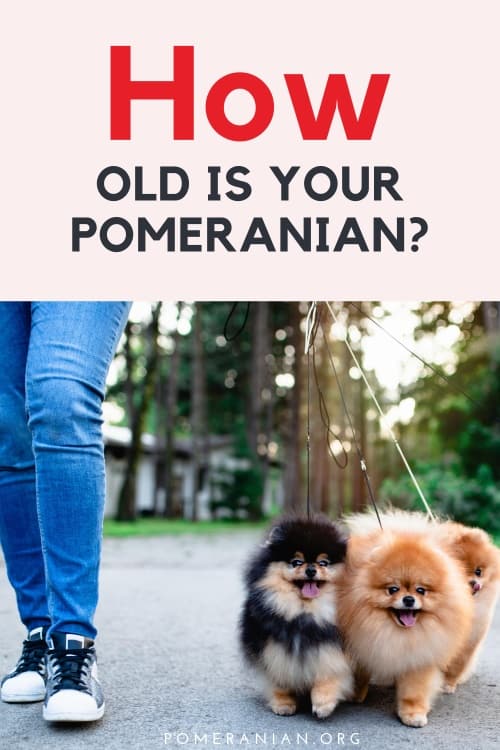Last Updated on 25/04/2024 by Dochlaggie. Post first published on December 23, 2022.
You would like to know how old your Pomeranian is in human years. We have included a Pomeranian age chart to help you understand how Pomeranians age.
We’ve compiled this simple guide to help you understand how old your Pomeranian is in human years. From young adulthood to twilight years, find out how to calculate your Pomeranian’s age in human years below.
Although there isn’t an exact science to aging dogs, follow our easy steps, and you’ll have a good idea of where your pup falls on the spectrum. With this newfound knowledge, you can ensure your dog gets the proper care they need as they age gracefully.
Everyone knows that dogs age faster than people. The claim that a Pomeranian age in human years is seven years for every year that a human age is a fallacy. Dog breeds vary in speed that they age.
Because there are hundreds of dog breeds, scientists needed an easy method for calculating a dog’s age. That’s when the “rule” of 1=7 came into being.
This Pomeranian lifespan in human years is a method people have used for decades. However, it doesn’t explain how canines actually age.
The age of dog breeds varies according to whether they’re a toy, a small, medium, or large dog. The physical body of a breed also affects how fast it ages.
Quick Pomeranian Age Facts
- A Pomeranian typically lives for 12-16 years.
- In human years, this would be equivalent to a person aged 60-80.
- Pomeranians age more quickly than people, so they reach seniority sooner.
- A Pom’s life expectancy can be affected by several factors, including diet and lifestyle.
- Therefore, when adopting or purchasing a Pomeranian, one must be prepared for a long-term commitment.
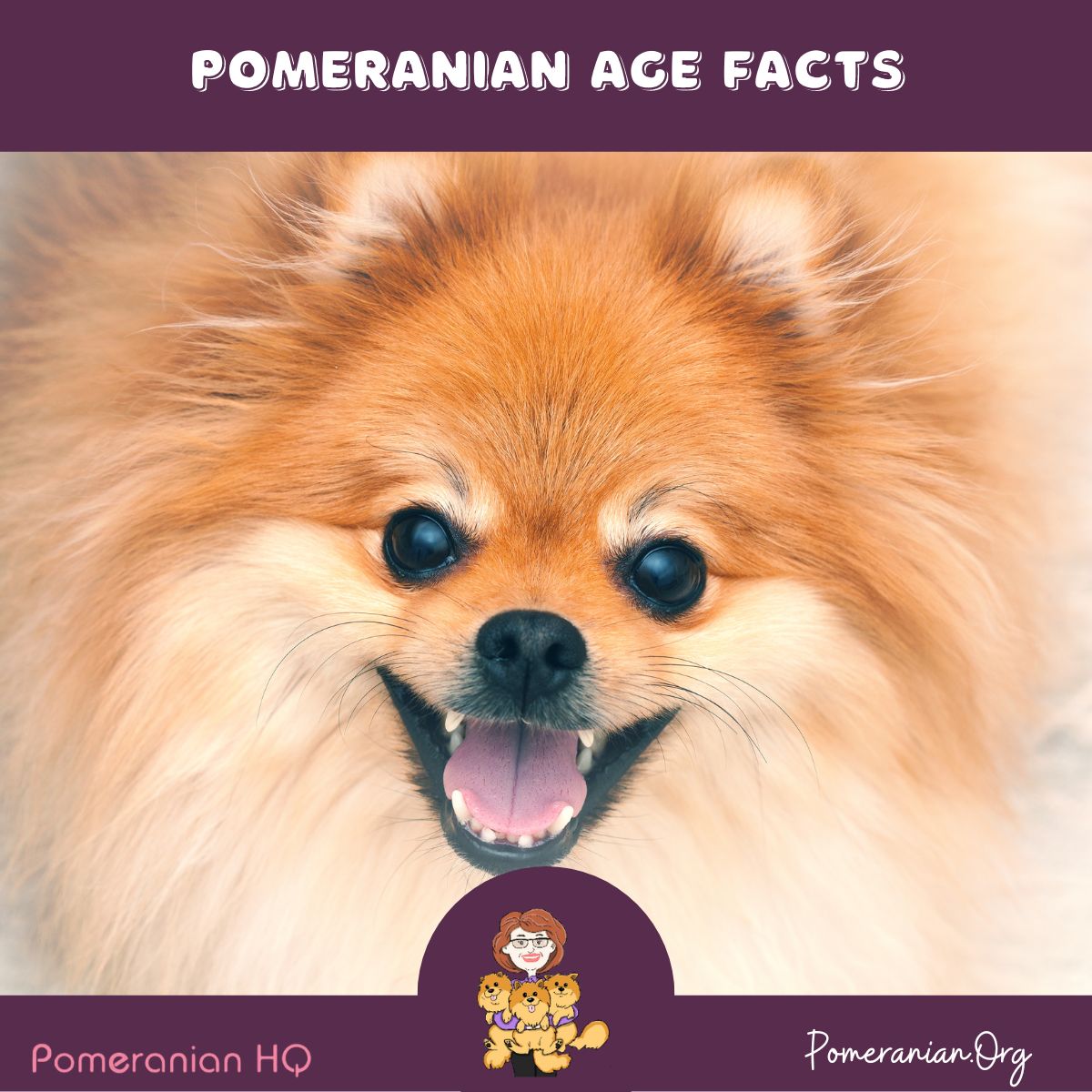
How Do Pomeranians Age?
The needs of a Pomeranian will differ as he grows old. Like people, dogs within a specific breed are also unique, so their age, physical body, and other attributes will vary as well. Pomeranians and other small dogs usually live longer than bigger dog breeds.
Aging signs in Poms may appear when he’s as young as seven years, as old as eight years, or anywhere in between. In the 1930s, a dog’s lifespan peaked at seven years. Today’s Pomeranian dogs can live into their late teens and beyond if they’re properly cared for and remain in good health.
Most vets measure and assess the human age equivalent of a dog based on how much he weighs. Below is an accurate chart to help you measure Pomeranian dog years to human years.
Pomeranian Dog Age in Human Years
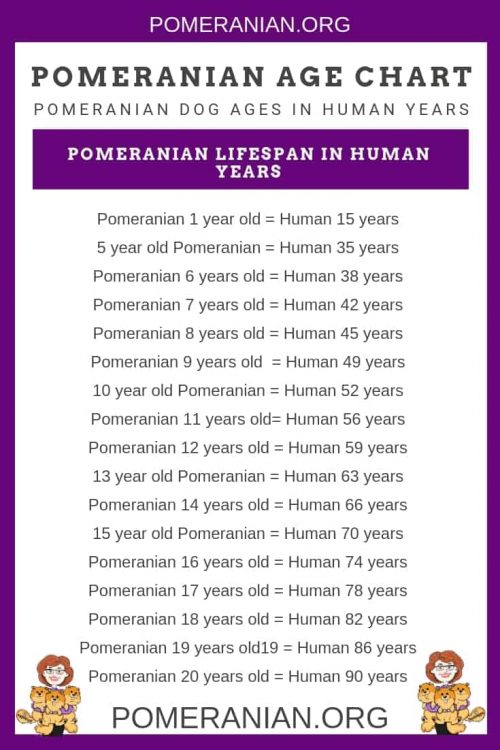
Age of Pomeranian Dog
1 – 6 weeks: Newborn. Eyes will open at two weeks. Puppies begin to walk by Week 3. Weaning is over by the end of the 6th week.
8 – 12 weeks: ‘New’ puppy. The world is theirs to enjoy. It’s all exciting, but they tire easily and need plenty of naps.
8 weeks to 1 year: The puppy will grow a lot during this period.
4 – 6 months old: He’ll undergo teething.
6 – 9 months: Puberty period. Females may come into season. Males possess viable sperm.
3 – 6 months: The ‘puppy uglies’ starts. His puppy coat is slowly being replaced by a new adult coat that may be darker or lighter. His color may alter during this period. Secondary colors may become stronger or fade.
10-month-old Pomeranian: Your Pomeranian should be at an adult weight and have a full adult coat.
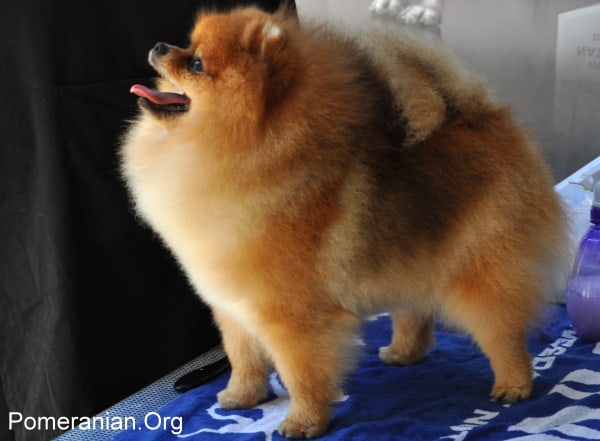
One-year-old pomeranian: Officially now a grown-up pomeranian with lots of energy. He’ll be equal to a human teenager of 15 years. He should be housebroken and understand most of the rules. He’ll be awake for more hours and will feel a powerful need to be with his owners. He may feel intense separation anxiety.
Pomeranian 8 years old: He’s regarded as a senior. There’s no official age at which he’s classified as a senior Pomeranian. Your vet decides but many wait until he is a 10-year-old Pomeranian. However, it’s essential to declare seniority because that means he needs a bi-yearly health check instead of only being done annually.
First-year Changes

Puppies may find it hard to only focus on a single thing at a time. When he’s 3 – 4 months old, there should be the beginning of a close bond between the Pomeranian and his owner. Some owners will see that his coat’s color changes. Examples: a black dog may become a black and tan parti, or a wolf sable may turn a solid grey color.
During the “puppy uglies” phase (aka heavy shedding period), the dog’s baby coat gets shed, and the adult coat begins to come in. If a senior develops some grey, there won’t be a full-color change.
During your Pomeranian’s first year, he will grow fast. Some Pomeranians will have a growth spurt, while others will start and stop a few times.
Once he’s one year old, he’ll be roughly the weight and height that you would expect from an adult Pom. Smaller puppies may take longer to mature and, in some cases, may not be fully developed into an adult until around the 18-month mark.
Bigger pups, on the other hand, might just be fast developers and be fully grown at 5 months.
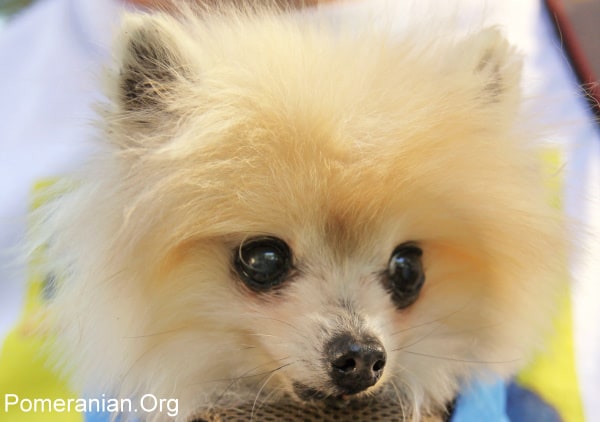
Pomeranian Aging Signs
The time from when your Pom was a puppy to the time when he’s a senior will flash by so fast you’ll wonder where it all went. Older dogs need a different type of care than young dogs. There are visible signs to indicate when your dog is getting old.
An old Pomeranian will eat less food, need a different type of food, won’t be able to exercise the way he did as a young dog, and will have more health issues that you need to be aware of. One major sign is that he’ll slow down in many ways.
He’ll be slower to walk up any stairs; to get up from his bed, to come when called, to eat, and to generally move about and walk.
Never assume he’s getting older if you notice these symptoms. He may have health problems such as arthritis and thyroid issues. Medication can treat many health issues so he can return to good health.
When your Pomeranian is a senior, a major life change is that he’ll need more vet trips. Every six months, he needs a complete check-up. Unless otherwise advised, most vets say to change the check-ups once your Pom turns eight.
A full physical will include the following:
Blood tests, a complete physical exam of every part of his body, from head to toe to butt and tail. He may need an electrocardiogram if certain concerns arise.
Depending on his history, other specialized tests may also be carried out. Between his regular check-ups, you need to be vigilant about anything out of the ordinary.
You must get your Pom to the vet if you observe any of the following:
- Sudden weight loss. This may be an extremely serious problem.
- Not eating…to the stage that no food passes his lips.
- Vomiting and/or diarrhea. If these signs last more than 24 hours.
- Increased appetite but no weight increase. This may indicate diabetes.
- Increased thirst and urination with no extra activities. May also indicate diabetes.
- Separation anxiety. If left alone, your senior Pomeranian may whine, bark, become destructive, and/or have trouble controlling his bladder and/or bowels.
- Confusion, disorientation, lack of attentiveness, roaming in circles, and being more withdrawn.
- Tiring faster than he did as a young dog. While it may simply be a sign of old age, it may indicate lung or heart disease. Excessive panting and coughing can mean heart disease. If he struggles to get his breath back after only a minimum of exertion, he may have pulmonary/cardio troubles and must go to the vet immediately. The vet will advise if he can still do exercises after a thorough exam and tests are conducted.
- Trouble getting up from his bed or any movements can mean he has arthritis. The vet will help you find other ways to ease his pain and assist in better mobility of his joints, including the possible use of supplements. An orthopedic bed can help him to sleep better, relax muscles and joints, and to assist him in rising in the morning.
- Hearing and sight problems are common in senior Poms. With hearing loss, clapping and/or hand signals instead of calling his name can get his attention more easily. If he has sight issues, don’t move furniture as he gets accustomed to the position of everything.
- Unusual aggressive behavior: Because his tolerance level for a lot of things has reduced in old age, he may get aggressive if the room is noisy if other dogs are running around playing, if he has painful joints and/or other parts of his body, a bad reaction to medication and anything else that upsets his preferred, comfortable routine.
Conclusion
To sum it all up, a Pomeranian dog’s age in human years is about seven years for the first year and then four years for every following year.
So, if your Pomeranian is two years old, it would be the equivalent of a 28-year-old human. Keep these conversions in mind when you are planning activities and caring for your pup!
Disclaimer: The Content is not intended to be a substitute for professional veterinarian advice, diagnosis, or treatment. Always seek the advice of your veterinarian with any questions you may have regarding the medical condition of your dog. Never disregard professional advice or delay in seeking it because of something you have read on ANY website.
Copyright Pomeranian.Org. All Rights Reserved.
References and Further Reading:
[1] Denise Leo, The Pomeranian Handbook.
[2] E.Parker, The Popular Pomeranian.
[3] L.Ives, Show Pomeranians.
